HOW FINANCIAL SERVICES ORGANIZATIONS CAN EFFECTIVELY CAPITALIZE ON AI
John Trapani, Industry Lead, Financial Services, Appian
CHALLENGES OF AI IN PAYMENTS
Adam Vissing, VP Sales & Business Development, IXOPAY
FINASTRA'S PERSPECTIVE ON THE ROLE OF WOMEN IN SHAPING THE FUTURE OF FINTECH
Helen Cook, Chief People and Communications Officer, Finastra

THE FUTURE OF PAYMENTS IS OPEN –BUT IT’LL TAKE TIME
THE FUTURE OF PAYMENTS IS OPEN –BUT IT’LL TAKE TIME
www.financialit.net • Spring Issue • 2024
Siamac Rezaiezadeh, VP of Product Marketing and Insights, GoCardless


REAL INTELLIGENCE ABOUT ARTIFICIAL INTELLIGENCE
This may turn out to be the most important edition of Financial IT magazine that we have published since the launch of the publication in November 2012.
The key reason is that the main focus of this issue is a topic that is a source of great risk to the global economy and society. That topic is Artificial Intelligence (AI).
At the beginning of the year, political consultancy Eurasia Group published its Top Risks 2024 report, which explains what its experts see as the top challenges for the coming 12 months.
 Andrew Hutchings, Editor-In-Chief, Financial IT
Andrew Hutchings, Editor-In-Chief, Financial IT
The preface to that report noted the following:
“The wild card, more than ever, is technology – specifically, artificial intelligence. The upsides will start materializing more dramatically as new applications find their way into every major corporation across every economic sector. And as hundreds of millions of people begin to upskill themselves in their jobs, AI will become a copilot before it takes over your job. But the technology is also developing far faster than the ability to govern it, and a technopolar world for artificial intelligence means crisis response and reaction will come only after things break … let’s hope in 2024 those things aren’t that big.”
Those of our contributors who focus on AI convey messages that are consistent with this somewhat cautious view. A survey cited by one contributor notes that banking is likely to be one of two industries that spend most on AI. AI can contribute to fraud detection, improved risk management and more. However, it remains to be seen whether the relationship between humans and AI is a harmonious one. The speed at which suitable regulations are introduced is also as yet unclear.
Moreover, as another of our contributors points out, people mistrust AI. While some 88% of Indian consumers say that they are familiar with AI, and 79% claim to have experience with it, the figures are much lower in major English-
speaking countries. The solution appears to be strong data governance, transparency about how AI is being used and – perhaps most importantly – the education of consumers.

2 Editor's Letter
Yet another of our contributors, a large and well established European fintech, highlights the limitations of AI and why –for now – it has only a limited role in the company’s business.
AI is generating many conversations – and, indeed, debates – a lot of which feature in this edition of Financial IT.
There is more to watch than just AI…
A number of our contributors to this edition of Financial IT have drawn inspiration from International Women’s Day on 8 March 2024. They advocate the greater inclusion of women in fintech – and, especially, at senior levels in organisations. Naturally, we agree.
As a final suggestion, we urge that you keep a copy of this edition, and compare it with the edition that we publish in a year’s time. The key question will be: how does
what is being said about AI in early 2025 compares with what was being said in early 2024?
The answer to that question will be illuminating. At one extreme, it could be that AI is somehow at the centre of a massive crisis that has spooked all governments. At the other extreme, it could be that AI is clearly providing a bonanza for the financial services industry and is preventing – rather than causing – major problems.
The answer will likely be somewhere in between. In any event, a comparison of this edition of Financial IT with the one that we publish for the Spring of 2025 will provide real intelligence about AI – and about the progress of women in fintech…
Andrew Hutchings, Editor-in-Chief, Financial IT

Although Financial IT has made every effort to ensure the accuracy of this publication, neither it nor any contributor can accept any legal responsibility whatsoever for consequences that may arise from errors or omissions or any opinions or advice given. This publication is not a substitute for professional advice on a specific transaction.
No part of this publication may be reproduced, in whole or in part, without written permission from the publisher. Entire contents copyrighted. Financial IT is a Finnet Limited publication. ISSN 2050-9855
Finnet Limited
137 Blackstock Road, London, N4 2JW, United Kingdom +44 (0) 208 819 32 53
Editor-In-Chief
Andrew Hutchings andrew.hutchings@financialit.net
Publisher
Chris Principe chris.principe@financialit.net
Managing Director Eddie Heaton eddie.heaton@financialit.net
Editor Suhair Keshodia suhair@financialit.net
Research
Abdu Turdialiyev
Jamshid Samatov
Production/Design
Timur Urmanov
PM & Marketing Nilyufar Sodikova nilyufar.sodikova@financialit.net
Founder Muzaffar Karabaev
Spring Issue • 2024
LOOKING BACK MIRROR
When you look in the mirror who looks back at you? Did you ever have the feeling that there is someone looking back at you?
I feel that sometimes and it makes me think of what they see. Yes, it is me they see but what does that mean? Do they see what I want or do they see something else … interesting.
What do you see when you look at Financial IT? Is it the view that we want you to see or something else?
Names, titles, labels, etc., all give a certain first impression. There is a bank named Bank of Bird-in-Hand in Pennsylvania: what does their name say about their financial services? The First Sleepy Eye Bank of South Dakota tells you what about their vision of banking?
For Financial IT, the name tells you that you will hear about the intersection of finance and technology. What we try to be is the voice of vendors, suppliers and companies to the banks and financial communities. We are the platform for their products and services to be seen and heard by banks, governments, and big corporates.
Are we doing that? Yes, though this can be done better, broader, and more consistently.
There is much knowledge in the financial community.
A lifelong banker said to me: “Let me tell you. You are not a banker — you won’t understand.” He was thinking the wrong way. The providers of products and services understand much more about their focus than the bankers do. These products and services are based on careers that have been specialized in a particular area or niche of
banking. The experts with the narrow focus understand more than the bankers with their broad view.
Our companies design, build and implement specific elements of banking. They spend years on a narrow segment – which uniquely qualifies them as true experts. They are the ones finding new avenues for the banks to provide customer benefits, and new revenue streams for the financial community.
Companies that provide payments, FX, trade, online banking, and other services are doing what the banks have very limited capacity to do for themselves. Their main business is banking, while our clients provide solutions for banking.
What they provide is critical for the development of banking. Without them there would not be banking as we know it today. More importantly, there would not be the banks of tomorrow.
We don’t ask bankers what will be coming. Instead, that question is answered by the companies that are presented within Financial IT. The new opportunities for banks to do more for their client base come from the companies that are their providers. Even armed with stacks of research, the banks need companies that breath fresh air … and that in turn, improves the viability of our economy.
Financial IT therefore provides a crucial service. Not being a banker and working in a bank, visionary people are at risk of being deemed outsiders and having their ideas dismissed. There is a real danger in this traditionalist view.
In financial services, we often talk about
 by Chris Principe, Publisher, Financial IT
by Chris Principe, Publisher, Financial IT
legacy technology and how it prevents incumbents from being able to meet the changing needs of their customers. But what hinders us isn’t only the tech, but the mindset. Lines of code can be written and rewritten, but not legacy thinking. We can change the way banks operate and work, but it is important to change the way bankers think about these relationships.
This is indeed the raison d’être of Financial IT. We would all like to change the world, but instead if our efforts provide a bright light on providers to the banks, we have done our job.
Our collective responsibility is to highlight a changing world.
The commitment of Financial IT is to our customers and what keeps them up at night. You don't need to be a bank to demonstrate a new innovative approach. In fact, better that you are not. This is what our clients do every day. This is what Financial IT does every day. We give voice to the true experts in the field of finance. This year, Financial IT will be more focused, adding new products to ensure that our clients’ voice is heard and paid attention to. Stay tuned for a ride that challenges everyone and results in strong beneficial partnerships.
The looking back mirror will show us as we really are.
Chris Principe, Publisher, Financial IT.
Back to the Table of Contents Publisher’s Letter 4



EDITOR'S LETTER
2 REAL INTELLIGENCE ABOUT ARTIFICIAL INTELLIGENCE
Andrew Hutchings, Editor-In-Chief, Financial IT
COVER STORY

10 THE FUTURE OF PAYMENTS IS OPEN – BUT IT’LL TAKE TIME
Siamac Rezaiezadeh, VP of Product Marketing and Insights, GoCardless
PUBLISHER’S LETTER
4 LOOKING BACK MIRROR
Chris Principe, Publisher, Financial IT
LEAD STORY
14 HOW FINANCIAL SERVICES ORGANIZATIONS CAN EFFECTIVELY CAPITALIZE ON AI
John Trapani, Industry Lead, Financial Services, Appian
18 CHALLENGES OF AI IN PAYMENTS
Adam Vissing, VP Sales & Business Development, IXOPAY
20 FINASTRA'S PERSPECTIVE ON THE ROLE OF WOMEN IN SHAPING THE FUTURE OF FINTECH
Helen Cook, Chief People and Communications Officer, Finastra
FEATURED STORY
22 THE POTENTIAL OF GENAI IS HUGE. WHAT’S STANDING IN THE WAY FOR FINANCIAL SERVICES?
Rob Hudson, SVP, Group Executive and Head of International Banking & Payments, FIS.
24 WHY EMBEDDED FINANCE IS THE NEXT BIG THING IN FINTECH
Korbinian Krainau, Associate Managing Director, Strategy at Publicis Sapient
26 BEYOND CONSUMER DUTY: EMBRACING TRUE CUSTOMER CENTRICITY IN BANKING
Andrew Stevens, Principle, Banking and Financial Services, Quadient
FEATURED STORY
28 HOW EMBEDDED FINANCE IS REDEFINING CONSUMER JOURNEYS
Jessica O’Hare, VP of Product, YouLend
30 FOUR WAYS AI WILL TRANSFORM FINANCIAL INSTITUTIONS FROM THE INSIDE OUT
Marco Santos, CEO Americas, GFT
32 DIVERSIFYING THE FINTECH: PAVING THE WAY TO SUCCESS
Samantha Fogerty, COO, Payl8r
34 HELPING WOMEN THRIVE IN FINTECH
Sarah Whipp, CMO, Spendesk
36 EMPOWERING WOMEN IN FINTECH: ANASTASIIA BRENER'S TRAILBLAZING JOURNEY
Anastasiia Brener, Chief Commercial Officer, Akurateco Payments Orchestration Company
40 CYBERSECURITY: THE HUMAN FACTOR
John G. Wensveen, Ph.D., Chief Innovation Officer, Nova Southeastern University, Executive Director for the Alan B. Levan NSU Broward Center of Innovation, Official Advisor on Innovation, Technology and Entrepreneurship to the Broward County Mayor, Official Member of the Forbes Technology Council.
Anthony Weeks, Chairman and Managing Director of SEDI-CASE: ARCIPELO-TECH/ BrVo Cybersecurity Initiative, in partnership with US HART and RX5 Cybersecurity Strategic Alliance and Chairman Special Economic Envoy to Taiwan and Asia-Pacific Region
8 Back to the Table of Contents Contents
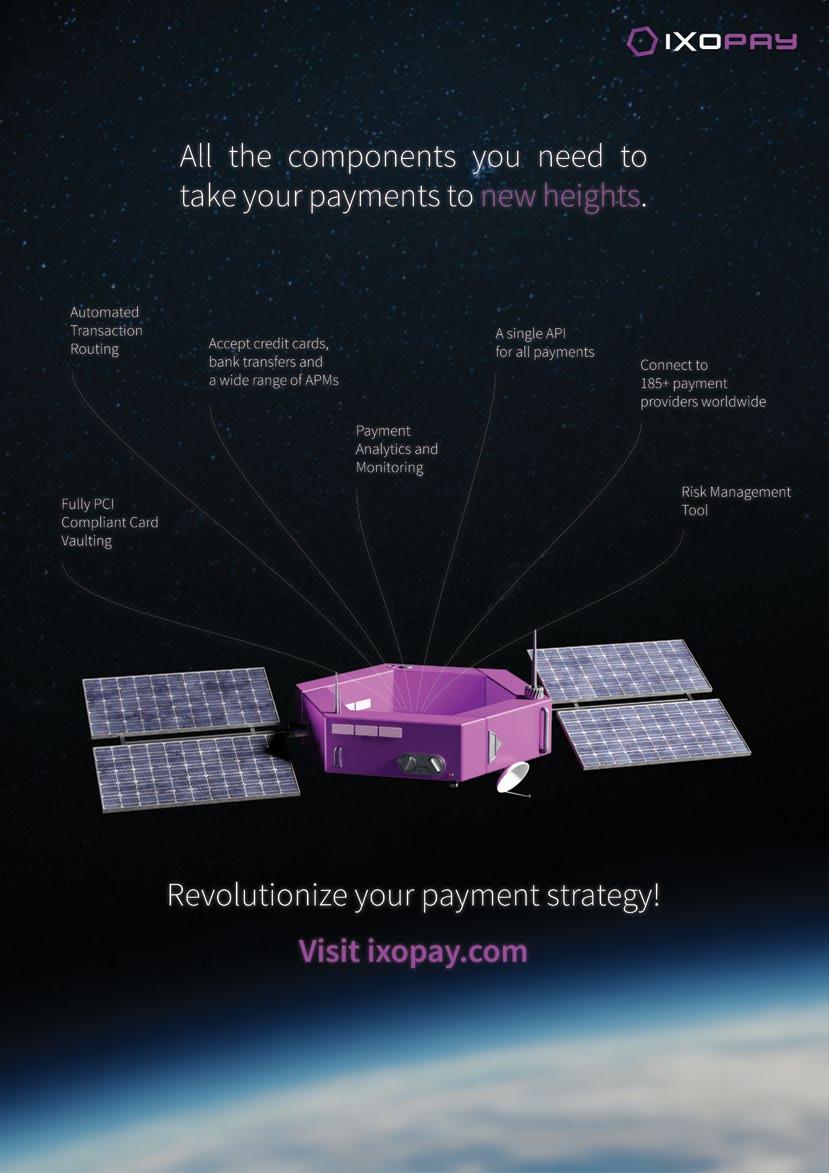
 Siamac Rezaiezadeh, VP of Product Marketing and Insights, GoCardless
Siamac Rezaiezadeh, VP of Product Marketing and Insights, GoCardless
THE FUTURE OF PAYMENTS IS OPEN –BUT IT’LL TAKE TIME
Six years. Enough time to earn that ‘iron’ wedding anniversary gift. Enough time for a human being to transform from a newborn that sleeps 16 hours a day into a child that can read, write and play team sports. And enough time for a new technology to grow from a theoretical idea to an innovation used by over eight million people and businesses.
It has now been six years since the launch of open banking in the UK. We’ve made great strides over this period, in particular in the arena of payments. Open banking-enabled payments topped 12m a month in November with more than one in nine (11%) British consumers now being active users. These figures sound, and are, impressive yet they’re a drop in the ocean compared to the total number of payments made in the UK in 2022 – 45.7 billion.
True evolution in open banking is inextricably linked to the fortunes of the Fintech companies that are forging new ways to disrupt and disintermediate the status quo of the banks and the card networks. Without them, who is going to be driving the innovation and competition
that was the purpose of PSD2 and open banking in the first place? Incumbents with entrenched interests in the status quo? Unlikely.
But life is tough in the Fintech startup world with growth v. profitability v. funding challenges coming to bear on the sector. With the current macroeconomic environment set to continue, it warrants a closer look at what is going on with payments and open banking.
At GoCardless, we firmly believe that open banking will play a significant role in the future of payments. Open banking is here to stay – use cases for both the data and the payments side are evident and early adopters, both businesses and consumers, are seeing the benefits. Indeed, in his recent Future of Payments Review, Joe Garner identified open banking as the primary solution to resolve a longstanding pain point for UK merchants: high card fees.
But it’s going to be a long road to mass adoption. For open banking payments to truly be ubiquitous we need the ability to collect recurring real-time payments
Back to the Table of Contents Spring Issue • 2024 11 Cover Story
across every use case. Payment conversion rates need to improve as does the user experience across banks. Integration into digital wallets will boost adoption as will the development of other aspects that give consumers more control.
All of this represents a lot of work and is reliant on a public policy approach that is supportive of these changes.
Recently we saw the Joint Regulatory Oversight Committee (JROC) set out an ambitious programme to take forward recommendations for the next phase of open banking in the UK, including a roadmap for a pilot of commercial Variable Recurring Payments (VRPs). We applaud this initiative and have contributed to its development, including through having seats on various regulator-led working groups, but the reality is that progress has been slower than we and other fintechs would like.
While off to a promising start, adoption will take years as consumers learn to accept and, more importantly, trust these new approaches to paying and sharing bank account information. And let’s not forget the time it will take for businesses and platforms to adopt, integrate and promote open banking services. One approach that we’ve seen merchants taking is incorporating open banking payments
About GoCardless
into their strategy either in conjunction with or via a provider who also supplies traditional tried and tested methods, offering a fallback mechanism.
With such a broad range of factors in play, it’s not surprising that fintechs need to be prepared to play the long game. Sustaining the long-term effort needed to drive changes in regulation, increase consumer awareness and encourage business adoption requires patience, deep pockets and a stable, preferably revenue-generating, core business. The macroeconomic environment has changed. Funding is less readily available so Fintechs need to be able to fund this effort themselves.
Interestingly, the current economic climate is pushing businesses to reassess what they want from their payment service providers (PSPs) too. Based on a recent survey commissioned by GoCardless* over half of the businesses surveyed use three or more PSPs and one in ten use at least five. With cost reduction at the top of their priority list, it’s not surprising that two-thirds of those surveyed are looking to consolidate their PSPs, and 34% are planning to do so in the next 12 months.
With 31% willing to pay more for a wider range of payment methods, it looks like a ‘one-stop-shop’ will trump ‘best-
of-breed’ for many merchants. Increased collaboration and integration amongst PSPs may well provide open banking with the boost that’s needed.
The first wave of open banking players were founded in more buoyant, optimistic times. Difficult choices are being made and growth is being curbed as we see layoffs across the Fintech and wider tech sector. Will we see companies disappear from the market? Undoubtedly. And we think that’s a shame. Innovation and collaboration between businesses and banks is essential for open banking to thrive.
As we head into the sixth year of open banking we believe the future is still bright, but the road is long. Open banking has opened the door to creating a bank payment network that can rival the current card monopoly, bringing lower-cost, direct bank payments to businesses of all sizes. It’s a vision that is going to take time and focus to achieve. The end game is going to be good for consumers and good for businesses. The sunlit uplands are ahead, but it will take time to reach them.
* For more information download the ‘Embedding a Competitive Edge’ report https://gocardless.com/guides/posts/ embedding-a-competitive-edge-report/
GoCardless stands as a global frontrunner in the direct bank payments sector, offering support to over 85,000 businesses ranging from start-ups to well-established brands. This support enables them to manage both recurring and one-off payments efficiently, eliminating the need for follow-ups, reducing stress, and avoiding high fees. Annually, GoCardless handles over US$30 billion in payments spanning more than 30 countries. Through its acquisition of Nordigen, GoCardless has expanded its services to include aiding businesses in making quicker and better-informed decisions by providing simplified access to bank account data. The company's main office is located in the UK, with additional branches in Australia, France, Latvia, and the United States.
Back to the Table of Contents Cover Story 12

HOW FINANCIAL SERVICES ORGANIZATIONS CAN EFFECTIVELY CAPITALIZE ON AI
For the banking and financial services industry, artificial intelligence isn't just a new tech trend; it's a powerful tool that has a wide range of impacts, from risk management to operational efficiency to customer experience.
According to Deloitte, the world’s top 14 investment banks could potentially boost their front-office productivity up to 35% by leveraging generative AI. And McKinsey & Company predicts that AI could boost the value of the banking industry by an additional $200 billion to $340 billion annually. That might explain why IDC projects banking will be one of the two industries spending the most on AI solutions in 2024.
AWS Cloud Technologist Piyush Bothra noted in a recent interview that while algorithm-driven trading has been used for many years, there’s still great potential for financial organizations to use AI in other areas, like fraud detection. “Think about the billions of requests coming through financial systems from various sources and places across the globe. It’s just not possible to analyze all the requests and data flows and still get insights using traditional analytics. That's where AI can help,” said Bothra.
However, with this opportunity comes risks. Data privacy, security, and AI hallucinations are some of the considerations leaders will need to address to ensure they get the most out of their investments in AI.
AI use cases: risk mitigation, fraud prevention, and beyond.
AI will continue to have a transformative impact on the financial industry, especially in
areas like risk and compliance. By harnessing automation and machine learning, banks can gain real-time visibility into emerging risks, make informed decisions driven by data, and optimize risk management processes with precision to account for changing regulations.
And taking risk management a step further, data-agnostic AI solutions help financial firms prevent fraud and financial crime. AI can enhance existing systems to better identify previously missed transactional patterns, data anomalies, and suspicious relationships that may indicate fraud. It looks for suspect patterns of behavior at a large scale and learns to detect new ones over time, continuously improving its accuracy and efficiency.
Beyond managing and mitigating risk, AI’s remarkable capacity to process and analyze vast amounts of data quickly can transform the dynamics of client relationships at financial companies. It can help banks determine what products and services a customer may need by analyzing their data as well as speed up workflows for things like loan application processing.
Similarly, internal teams can benefit from AI for document and query management. AI can summarize documents, draft emails, gather details for due diligence questionnaires, and more. It can also extract the most relevant data from a document, categorize it, retrieve related information, and plug it all into another system for analysis, supporting processes for things like making credit decisions.
Navigating the future of AI.
Adopting AI is not without its challenges. Banking and finance leaders need to
implement stringent AI governance and controls to address issues related to things like intellectual property, misinformation, and data privacy.
1. AI regulations are coming.
If 2023 was the breakout year for AI, expect 2024 to be the year of AI regulation. Regulations have started to take shape in the United States, among other countries, as governments recognize the potential impacts AI could have on society—from user privacy concerns to misinformation to cybersecurity risks. The European Union has even been considering publishing its own AI Act to curb potential misuse of the technology.
While most of the discussions to date have painted in broad strokes how we might start to address major concerns, business and IT leaders should expect more comprehensive privacy legislation in 2024 in the form of privacy laws and governance frameworks from the United States Congress and regulatory agencies. Business leaders should plan now and understand how they will adapt to these impending regulations.
2. Humans and AI should work harmoniously.
Integrating humans and AI in collaborative efforts is crucial to operationalizing and maximizing the value of AI. Unlike the dystopian narratives that envision AI replacing humans entirely, the current reality emphasizes a more balanced, mixed autonomy approach.
AI lacks the autonomy to replace human judgment or expertise entirely—a big reason why business and IT leaders need
Back to the Table of Contents
Lead Story 14

to develop a strategic vision for mixed autonomy, leveraging AI to augment human capabilities rather than supplant them. Process is the necessary layer for organizations to route tasks between humans and AI automations effectively. Companies will increasingly rely on AI to accelerate common tasks, but they must ensure humans maintain control and oversight of business processes.
This human-AI partnership is exemplified in processes like content generation, where AI can propose work, but human oversight is essential to ensure accuracy and quality. For instance, in lending, where sensitive information is involved, human intervention becomes critical to verify that AI-generated messages are correct, read well, and don’t include personal data where they shouldn’t.
3. Businesses will need private AI.
While public AI models started the recent AI craze, pressing data privacy concerns have quickly cut the blind infatuation short. Many large public cloud providers offer AI services to organizations, but, unfortunately, these cloud providers often train their public AI algorithms on their customers’ data without disclosing how it’s being used. Businesses may unwittingly put their data at risk or assist the competition by helping train widely available algorithms.
While some sectors can tolerate these risks, industries like financial services where security is paramount can’t afford them. To avoid data privacy issues in AI services, organizations must strategically limit AI usage to areas where privacy can
John Trapani, Industry Lead, Financial Services, Appian
John Trapani is a Global Industry Leader at Appian Corporation, working with leaders in Financial Services to help drive growth and create opportunities for digital transformation using the Appian automation platform. In this role he works to ensure Appian delivers applications that help drive growth, manage risk, and increase the efficiency and effectiveness of their business processes.
be better assured; otherwise, they must choose to only work with vendors who take a private AI approach that provides better protection.
Private AI is an approach to AI that focuses on building and deploying AI technologies that respect the privacy and control of users’ and organizations’ data. Private AI models train only on your data using models proprietary to you, all of which remains fully under your control. A true private AI vendor will not share your data or use it to fine-tune models in any way. And private AI outputs are tailored to your organization, which can make them far more accurate than public AI outputs.
For example, let’s say you want to build a private AI model that classifies incoming documents. With low-code design, you could quickly train a model using real documents you received as a representative data set. From there, the AI model could classify future incoming documents automatically. This model would remain private to you and would generate more accurate results and classifications because the data it’s trained on is entirely from within your organization.
AI success rests on a foundation of data and process.
AI is not a standalone technology. To maximize its value, you must also have two foundational components: data and process. Data is the intellectual fuel for AI. The value AI brings to your organization is directly proportional to the quality of the
data you feed it. And the best way to feed it good data is to use a data fabric, a semantic layer that connects data from systems across the organization to create one unified view.
Strong processes are necessary to operationalize AI and route tasks between humans and AI workflows effectively. Leading organizations understand that success with AI requires human intervention, and this mixed autonomy is what builds strong, reliable enterprise process automation.
Combine artificial and human intelligence to make the most of your investment.
AI applications in finance will continue to grow, and companies that adopt this technology sooner rather than later will have an edge against the competition. To get the most out of that investment, financial services organizations need to be thoughtful about implementation.
That’s why it’s critical to future-proof your AI efforts—and the future belongs to private AI. While private AI is partially a philosophy, it’s also a practice that is critical for safeguarding data. Combining private AI with human talent that has knowledge of how to best implement it will help organizations use it most effectively.
Back to the Table of Contents Lead Story 15 Spring Issue • 2024

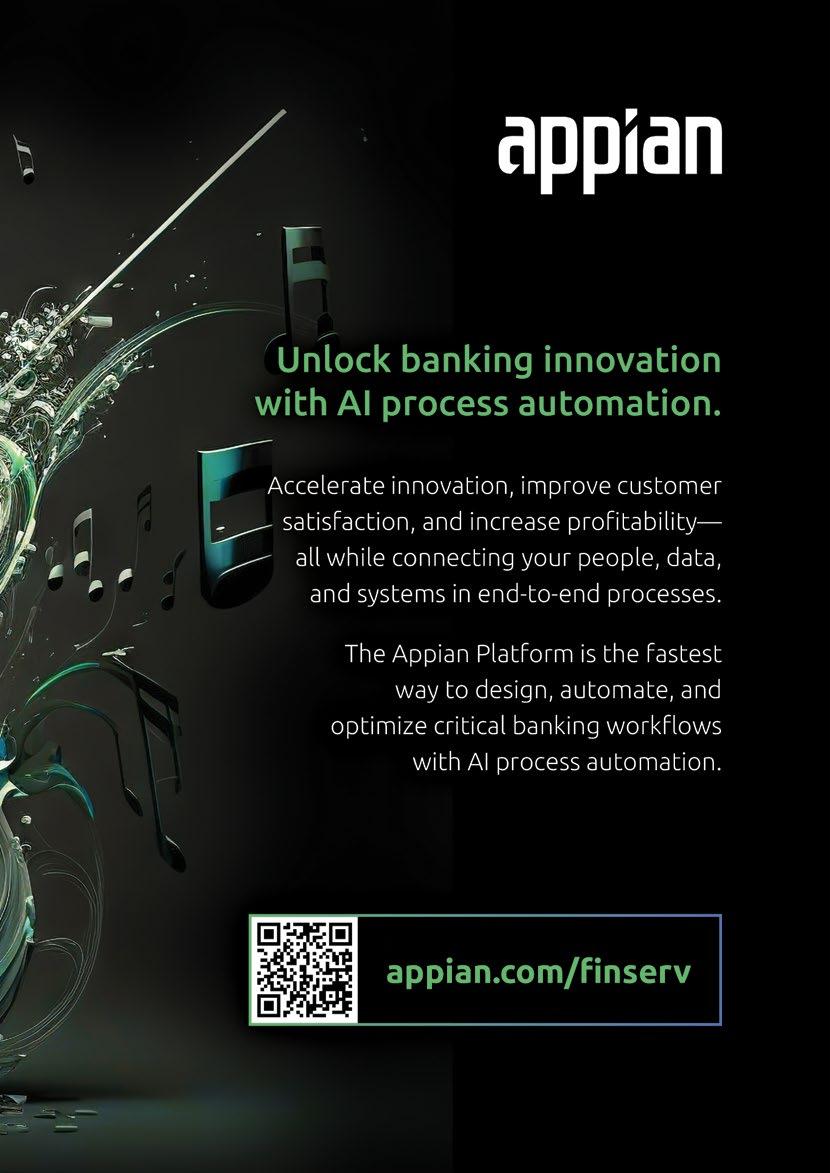 Adam Vissing, VP Sales & Business Development, IXOPAY
Adam Vissing, VP Sales & Business Development, IXOPAY
As VP Sales and Business Development for leading Payment Orchestration Platform IXOPAY, Adam supports global clients in designing and implementing scalable payment infrastructures.

CHALLENGES OF AI IN PAYMENTS
Prospective clients regularly ask whether IXOPAY uses AI to route transactions to the “best” provider. Considering the hype currently surrounding “AI”, such questions are not surprising. But within that question lies an assumption: that adding AI is the solution and will invariably deliver benefits.
However, AI – like any tool – is not necessarily suited to every task. We need to ensure that such systems deliver tangible benefits to our clients. The reasons we do not currently market AI-based functionality are therefore nuanced and complex.
Machine learning – which underpins most of these “AI” models – relies on large datasets to train a model. OCR is a classic example: the training data contains a large number of known characters the system is tasked with identifying. Initially, the success rate will be very low. However, by providing feedback on whether an answer is correct, the system slowly converges on a model with a high degree of accuracy.
The quality of the training dataset is important, particularly to address the “cold start” problem. Think of YouTube, Spotify or Amazon’s recommendations. When a user signs up, the system knows nothing about the user’s preferences. It is only once the user begins interacting with the platform – watching videos, searching for products or listening to music – that this data becomes available. This data takes time to collect and curate and, if handled poorly, leads to results like Spotify revealing in 2014 that 20% of content on Spotify had never been played. This is not the sort of behavior you want from a critical system.
So how do you train a model to predict the “best” PSP for a given merchant without sufficiently relevant historical data? You might choose to use data from merchants in a similar industry – but even that approach has its pitfalls. Case in point – a number of large cryptocurrency
exchanges use IXOPAY, and the vast majority of their transactions are USbased. A limited number of issuers account for the vast majority of US credit cards, and a limited pool of acquirers are willing to work with cryptocurrency exchanges. These exchanges are thus all dealing with the same issuers and acquirers. You might expect similar results: same industry, same banks and similar transactions. But what we actually see are significantly disparate authorization rates across this subset of our client base.
How can we explain these stark differences in this scenario? One answer is issuer outreach. Exchanges with higher authorization rates invest time and resources into reaching out to issuers, assuring them they are legitimate, with compliance, AML and fraud management processes in place. So while issuer outreach is a decisive factor in determining authorization rates, it is not represented in the raw data at all.
A merchant’s MCC also influences authorization rates as it is used by issuers and acquirers to balance their merchant portfolio risk, but this information is not captured as part of the typical transaction process – it flies “under the radar” in most cases.
Another risk to merchants is hidden bias: kickbacks are the norm in the payment industry. With this in mind, how can the merchant trust that a “payments routing AI” will be trained to recommend not what is best for the service provider (e.g. route to the PSP with the highest kickback), but for the merchant?
Legislation and compliance add even more complexity. Upcoming AI legislation will require explainability of AI-driven decisions, with financial services and payments likely being subject to the strictest requirements. Systems processing card data (including training systems) need to be PCI-compliant. Individual cardholder data, required to train the systems, is also
covered by GDPR. Future EU legislation will also require businesses to provide individuals with immediate access to all data stored on them. So while patterns in cardholder’s transaction data can be important to the chance of a transaction succeeding, using this data opens up a compliance can of worms.
Finally, there is the question of liability – if poor AI decisions result in monetary losses, who is liable? The payment orchestration platform? The merchant who opted into the service, fully aware that it was AI-based? Many questions are yet to be answered. A system built today could end up no longer fit for purpose in just a few months as legislation is enacted.
While we are actively researching and testing potential applications of AI/ML in payments, we are erring on the side of caution, instead of overpromising on tech that has yet to mature. AI is not a panacea; we will soon collectively enter the inevitable trough of disillusionment following a few years of unrealistic expectations. So while we’re working offering our merchants real benefits through AI, we will not promise something we cannot deliver just to surf the latest hype wave.



FINASTRA'S PERSPECTIVE ON THE ROLE OF WOMEN IN SHAPING THE FUTURE OF FINTECH
Building balance in fintech
International Women’s Day acts as an impetus for us all to reflect on the progress that has been made across the financial services industry, whilst also keeping us focused on the work we still have to do in order to forge a better, more inclusive world where we continue to strive for gender parity.
Given that women make up half the world’s population, it’s essential that they are appropriately represented across all areas of the financial services ecosystem. Those organisations that achieve a good gender balance and build teams with a wide range of intersectionality and perspectives are in a stronger position to develop products and services that are more representative and aligned to a wider cross-section of customers, partners and society in general.
Demonstrating such inclusivity is also important to our customers. Many customers ask suppliers to show credentials in order to participate in an RFP process. This makes gender balance not only a sound business objective, but a commercial imperative. According to McKinsey, if the global workforce became equally gender-diverse by 2030, global GDP would increase by $13 trillion.
Women bring a valuable range of skills to financial services and fintech organisations, far beyond simply filling a quota. Key areas where they often excel as part of a balanced team include in leadership roles, in technical innovation and in the core skills they bring in areas such as communication, conflict management and collaboration.
At Finastra we recognize the talents and achievements of all individuals. We’re increasingly seeing women making their mark in fields like data science and analytics, risk management and the development of new financial products and platforms. We see our female employees bringing a fresh perspective that helps drive innovation, and brings a greater balance to the conversation with different team members approaching the same project through a different lens.
Another area where women are often adept is in fostering effective communication and
teamwork, both within the organisation, and externally with customers and partners. This includes building strong relationships and collaborative environments, as well as problem-solving and interpreting and communicating complex information, using empathy and emotional intelligence.
While everyone’s skills and talents are individual, it’s clear that women bring a valuable set of skills to the table and have an important role to play in helping us, and other organisations, unlock our full potential.
Stronger together
Making gender balance a deliberate and purpose-led priority at Finastra sets the culture across our organization, and underscores our belief that diverse teams are ‘stronger together’. We have high standards and expect the same of partners and suppliers across our entire ecosystem.
Strong leadership and growth are two of the commitments we’ve pledged to our employees, and we are purposeful in nurturing our teams and giving them the opportunities to upskill and grow every day. For example, we’re providing all employees with access to a comprehensive generative AI skills training program. Knowing that it can be natural for people to resist or to fear change, we also have a variety of internal channels and communities in place that enable our teams to interact with experts, ask questions, and share knowledge in a safe and supportive environment.
In addition, we recognize the difference that flexible working models can make for those needing to juggle other responsibilities outside of work. Helping our people lead rewarding and fulfilling careers while ensuring a good work-life balance is a central part of our retention strategy.
We also aim to have strong role models within Finastra. You can’t be what you can’t see, so we work hard to ensure those on the path towards senior leadership have exposure to people at a senior level both inside and outside the organisation. Our people leaders also participate in ‘Licence to Lead’ training
programs to help them grow and to nurture and develop their teams in the most effective way, recognizing and rewarding the talents of every individual.
Research shows gender-diverse companies that are in the top quartile for gender diversity on executive teams are 25 percent more likely than fourth-quartile companies to have above-average profitability. While we focus on achieving balance across our executive and senior leadership teams (ELT & SLT) – we have a 50/50 balance at ELT level –we strive for an equitable balance at all levels.
Our global FinStarter graduate intake programs enable us to cultivate a strong talent pool and to achieve gender balance across all functions. This is a deliberate activity, and we’re ensuring we give it the focus it deserves, especially to build cohorts in our growth regions. This feeds upwards, helping ensure we have a strong and sustainable talent pipeline.
At Finastra we know that building a balanced workforce requires ongoing discipline and focus. Just like keeping fit, it’s something to be worked on continuously.
Celebrating achievement on International Women’s Day
For IWD this year, I’m honoured to be participating in a day of celebration taking place across all our offices around the world. We’ll be recognizing the contribution and achievements of women with onsite parties in all of our core locations.
By promoting gender balance and creating a more inclusive and equitable environment at Finastra and across our partner ecosystem, we’re ensuring that we’re stronger together. Our collective goal is to better serve our clients, manage risk, innovate, attract and retain top talent, and to build a strong, rewarding and sustainable future for all.

Back to the Table of Contents
Lead Story 20

Helen takes global responsibility for the People, Brand and Corporate Communications organisation and advancing Finastra’s aspiration to be the most inclusive and diverse employer in the fintech industry. She is particularly passionate about building a curious and well-tooled workforce, supporting employees to develop skills which keep them relevant, engaged and growing. Developing the company’s global talent and ensuring a truly inclusive workplace is her priority.
Helen was previously at Natwest Group, where she was a member of the Executive Team and held the position of Chief Human Resources Officer. She has an incredible wealth of expertise including extensive global exposure in all aspects of people strategy. Her career spans more than 25 years in financial services, including experience at Deutsche Bank and Morgan Stanley. Helen graduated from Cambridge University and is a Fellow of the Chartered Institute of Personnel. In addition to her role at Finastra, she has served on the Board of the Financial Services Skills Committee and on the Advisory Board of Ivy House. She also serves as a mentor for the FTSE 100 Mentoring Foundation.
Helen Cook, Chief People and Communications Officer at Finastra
THE POTENTIAL OF GenAI IS HUGE. WHAT’S STANDING IN THE WAY FOR FINANCIAL SERVICES?
AI is becoming ubiquitous in people’s lives, especially with the introduction of GenAI tools such as ChatGPT. GenAI offers many opportunities for both companies and consumers, from content creation to personalized recommendations. Our research, Trust in Generative AI, finds that despite the transformative potential, consumers’ understanding and trust of GenAI is mixed – and that’s preventing GenAI from maximizing its potential.
This confusion is no surprise given recent headlines and a lack of regulatory clarity. But if financial services firms can cut through the noise, they may find that consumers are more receptive than they think.
Who is using GenAI today?
According to our research, India is far ahead in terms of familiarity and usage – 88% of Indian consumers said they are familiar with GenAI, and 79% have experience using GenAI. Why? India has a dynamic tech ecosystem, and GenAI is not merely as a buzzword; major banks are using it to develop responsive and intuitive user experiences.
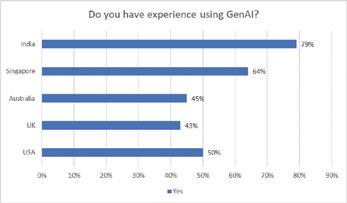
Of the countries we surveyed, Singapore is most similar to India, with 64% of Singaporeans saying they have experience using GenAI. Consumers in Australia, the U.K. and the U.S. are less likely to have used GenAI.
What’s blocking greater adoption?
In the case of GenAI, familiarity may breed trust. Indian and Singaporean consumers – who are more likely to have experience with GenAI – also have more trust in it. Only 3% in India and 8% in Singapore do not trust GenAI at all, versus 33% in Australia and 30% in the U.K. and U.S.
But resistance to GenAI goes beyond trust. Consumers also don’t see a need for it, plus they’re worried about data privacy.

Would you bank using GenAI?
Not surprisingly, consumers from the U.S., U.K. and Australia are also more likely to be very uncomfortable with their banks using GenAI – while only 3% of Indians and 5% of Singaporeans say the same. However, there is some hope for GenAI proponents: 41% of respondents in all five countries say they are at least somewhat comfortable with their banks using GenAI.
Over 40% of respondents in the U.S., U.K. and Australia are interested in exploring a Gen AI-powered financial application, and an overwhelming 91% in India and 74% in Singapore say the same. Most often consumers believe that using GenAI would save them time, though Indian consumers say they also simply like using new technology.
Featured Story 22 Back to the Table of Contents
 SVP,
SVP,
Rob Hudson is Head of International Banking & Payments at FIS. Prior to FIS, Rob served as the Chief Commercial Officer at Nets Group for four years, where he was instrumental in shaping the company's commercial strategies. His extensive experience also includes over 15 years at TSYS, where he progressed to a key leadership position as a Group Executive, managing the company's European operations. Before TSYS, Rob honed his expertise in product and partner management for nearly a decade, laying a solid foundation for his career as a Management Consultant at PWC. Rob's career is characterized by his commitment to driving growth and innovation in the financial technology sector.

Of course, many financial services providers are already using GenAI. From deeper insights into customer behavior, preferences and risk profiles to more effective marketing campaigns and more insightful research reports, GenAI offers intriguing opportunities for businesses. News organizations have reported on JP Morgan’s plans to develop a ChatGPT-like AI service that gives investment advice, while Bloomberg has announced BloombergGPT, a new large-scale GenAI model. The opportunities for consumers go well beyond that, with the chance to boost financial literacy, tailor services to individuals and improve portfolio performance.
But key consumer concerns need to be addressed before the industry can deliver the full value of GenAI.
Closing the trust gap
The flipside of that interest in GenAI is the fact that the majority of consumers in Australia, the U.K. and the U.S. aren’t interested in GenAI-powered financial applications. Will that change in the future?
We asked respondents if they would be more comfortable using GenAI in five years’ time. Indian and Singaporean consumers remain more enthusiastic, with 80% and 58%, respectively, saying they would be more comfortable. Australia, the U.K. and the U.S. continue to lag, with just 48% of those consumers agreeing that they would be more comfortable.
There are some promising signs though. 65% of consumers would stick with their primary bank even if they were using GenAI – and another 12% said they’d be more likely to continue using them. So, despite the hesitancy among many consumers, our research should
reassure providers that they can continue to adopt GenAI without weakening customer relationships. Regulatory clarity is another key piece to the puzzle, and that seems to be on the horizon (even if it’s a far horizon). The EU was among the first to take action, but US legislators and the Indian government are among those also considering rules. And although governments are taking different approaches, everyone will welcome greater certainty and oversight when it comes to GenAI.
The road ahead
In the meantime, providers and the industry as a whole can start addressing consumers’ concerns.
1. Adopt strong data governance and be transparent with consumers 30% of consumers say they don’t use GenAI because of data privacy concerns. Indeed, research from the Data Protection Excellence Centre found that many GenAI desktop applications have fallen short of GDPR and AI transparency standards. Firms must find ways to credibly reassure consumers that they will be protected, including providing details on their governance frameworks, incorporating human oversight and supporting relevant regulations.
2. Educate consumers about how – and why – to use GenAI
Many consumers simply don’t see the need for GenAI, or a reason to use it. But this technology offers tremendous benefits to consumers, from recommendations on how to improve their spending habits to making customer service interactions faster and more effective. The industry has a role to explain the value of GenAI to consumers.
With this two-pronged approach, financial services firms will be well-positioned to capitalize on the potential of GenAI while building greater trust with their customers and consumers at large.

Spring Issue • 2024 Featured Story 23 Back to the Table of Contents
Rob Hudson,
Group Executive and Head of International Banking & Payments, FIS.

Embedded finance is integrating financial services products seamlessly into nonfinancial journeys e.g., of retailers, ecommerce platforms, B2B companies, or even car interfaces. The promise is to reduce friction for customers, fostering growth for financial institutions, and creating alternative revenue streams for non-financial brands. While the idea of combining financial and non-financial offerings is not entirely novel, dating back to co-branded credit cards and traditional pointof-sale finance, the advent of decomposable architecture patterns has significantly facilitated the integration of financial products into digital non-financial journeys. This development has given rise to noteworthy players, especially in the payments sector (e.g., Stripe) and retail lending arena (e.g., BNPL players like Klarna).
Nevertheless, innovation in embedded finance, particularly beyond the realms of ecommerce payments and Buy Now, Pay Later (BNPL) offerings, has scaled infrequently in recent years, falling short of optimistic projections. Notably, banks have exhibited a slower and more cautious approach than anticipated in the execution of their ambitious embedded finance strategies, and some are choosing to roll back existing partnerships, as exemplified by the case of Goldman Sachs and Apple around the Apple Card.
Launching and scaling of embedded finance propositions faces several practical hurdles. These include potentially imbalanced risk-reward profiles, disparities in the pace of change, and gaps in comprehension of blended propositions between FS and nonFS firms. Non-FS enterprises understand their customers' needs well, yet they tend to face challenges in imagining how financial products can be woven into non-FS offerings to strengthen the proposition and generate additional value for the business. Conversely, FS firms often lack a nuanced understanding of customer behaviours beyond the financial services realm and struggle to establish
Korbinian Krainau, Associate Managing Director, Strategy at Publicis Sapient
WHY EMBEDDED FINANCE IS THE NEXT BIG THING IN FINTECH
a common language with their non-FS counterparts when exploring joint value propositions. Effectively bridging these comprehension gaps will help to sharpen and accelerate the development of innovations in embedded finance.
One promising frontier within the embedded finance landscape are "cardless" retail payments, enabled by P2P or openbanking transactions, positioned at the intersection of loyalty schemes. These propositions are underpinned by the prospect of cost savings for both retailers and customers, achieved by cutting out card network fees. Businesses further benefit from low-cost funding sources provided by proprietary digital wallets, as exemplified in the Starbucks wallet case. For customers these solutions enhance convenience by seamlessly integrating loyalty components, such as automated point accrual during transactions and customised offers. For cardless payment offerings to be thrive they must surpass the appeal of traditional card payments, which boast strong brand recognition, widespread acceptance, and frequently feature established loyalty programs.
To unlock the potential of cardless retail payments, both financial and non-financial entities should collaboratively address five questions:
1. Financial Incentives: Determine how to incentivise customers to opt for proprietary payment methods, potentially by distributing savings on card fees in the form of loyalty points, top-up bonuses, or interest on funds held in a digital wallet.
2. User Experience: Create an appealing user experience within a mobile app that integrates the payment mechanism with loyalty schemes. This may involve incorporating special offers, savings pots, and other features that drive customer engagement.
3. Customer Conversion: Develop strategies to convert payment users into customers of
additional products offered by the financial services provider, thereby enhancing the provider's ability to invest in and evolve the proposition.
4. Underlying Architecture: Design a flexible underlying architecture that integrates banking payments capabilities with the technology stack supporting the non-FS loyalty scheme.
5. Delivery and Change Model: Establish a robust delivery and change model that facilitates continuous evolution of the blended proposition with minimal friction between financial and non-financial entities.
Addressing these questions in the context of cardless retail payments will increase the likelihood of customer uptake and commercial value-add. As the industry continues to evolve, collaboration and strategic alignment between financial and non-financial brands more broadly will be crucial to unlocking the full potential of embedded finance and driving sustained growth in the sector.
Korbinian is part of the Strategy leadership team at Publicis Sapient. He advises clients in the financial services space in EMEA and APAC on digital business transformation, including value-driven strategy, operating model design, and underpinning technology enablers. At Publicis Sapient he is closely working with experts in the product management, technology, data & AI, and customer experience domains to design and deliver transformative change. Korbinian holds a B.Sc. and M.Sc. in Business from Mannheim University, Germany.

Featured Story 24 Back to the Table of Contents

BEYOND CONSUMER DUTY: EMBRACING TRUE
CUSTOMER CENTRICITY IN BANKING
With the introduction of the new Consumer Duty, the FCA has set a new bar for how banks serve and interact with their customers.
While placing customer needs at the core of business strategies is admirable, it does not automatically equal success. As with any regulation intended to improve best practice, from food hygiene ratings to data privacy, there is a vast difference between doing the bare minimum to meet standards, and going above and beyond to provide exceptional service.
We are at the beginning of a journey towards ingrained customer-centricity, and those that can exceed expectations will quickly gain an advantage over their competitors.
The current state of consumer understanding and support
In the midst of economic uncertainty, as consumers become increasingly constrained in their spending, clear and effective communication is paramount. Customers will be unlikely to forgive a bank they feel has given them inadequate, inaccurate, or incomprehensible advice. The current cost-of-living crisis has intensified the pressure on banks to provide support and advice. Yet consumers still struggle to receive the help they need when they need it. Whether this comes from an inability to contact the right person on a help line or chat window; or information arriving when it’s too late to do any good, or being filled with jargon. The consequences aren’t just a matter of customer inconvenience; they can impact financial well-being and ultimately consumer confidence in banks themselves.

One key element of the new Consumer Duty is communication. There remains a significant gap between what consumers think they know and their actual comprehension of financial matters. For instance, recent research highlights a telling disparity: while 39% of consumers claim a high level of knowledge on financial matters, only 8% could fully grasp the intricacies of updated overdraft charges when tested. This underscores an urgent need for banks to not only disseminate information effectively, but also ensure it is relevant to and understandable by each individual.
Effective communication, therefore, is not just about the transmission of information. It's about delivering the right message, at the right time, in the right language, over the right channel. Banks must find ways to present complex financial information in a manner that is easily digestible and that meets the diverse needs – and levels of understanding – of their customer base. By doing so, they can bridge the gap between their services and their customers' expectations, leading to more informed financial decisions and enhanced trust in banking relationships.
Featured Story 26 Back to the Table of Contents

Proactive vs. Reactive support in banking
The financial sector's traditional approach to customer support has often been reactive – waiting for customers to reach out with their problems before providing assistance. However, the evolving financial landscape, especially in light of increasing economic pressures, is prompting a shift towards proactive support.
For instance, banks could use analytics to identify customers who might be at risk of financial hardship – such as those with frequent overdrafts or missed payments – and reach out with personalised advice or modified payment plans. Proactive support could also involve educating customers about changes in the financial landscape that could impact them, such as tax increases or the end of government support schemes like the Energy Bill Support Scheme. This type of engagement not only assists customers in managing their finances more effectively but also builds trust and loyalty.
The importance of personalisation and segmentation
In an era where generic solutions are increasingly ineffective, banks
Andrew Stevens, Principle, Banking and Financial Services, Quadient
With nearly 2 decades of experience at one of the worlds largest banks, Andrew is ideally placed to ensure that Quadient’s product suite continues to evolve to meet the needs of today’s financial institutions. His resume covers all aspects of banking operations and technology with respect to customer communications management and customerexperience, and he has built a reputation as someone that can successfully execute complex international transformational projects in these fields. He earned his law degree at Sheffield Hallam University.
must embrace personalisation and segmentation. By analysing customer data, banks can identify individuals’ needs, tailoring their services and communications accordingly. For instance, does a customer always communicate via email, or WhatsApp? Do they have a high level of knowledge of saving options and interest rates, or are they a total newcomer? This strategy not only improves the relevance of the advice and products offered, but also enhances customer engagement and satisfaction.
For example, consider the different financial needs of a young digital native, versus a retired individual. The young person may naturally understand how to use internet banking and need no support on how to use an app. Whereas someone slightly older, who has registered for online banking the first time, may benefit from additional advice on how to navigate through the system and selfservice. By segmenting their customer base and personalising communications, banks can provide each of these groups with relevant and valuable information and services, rather than a one-size-fitsall approach.
Personalised communication is critical, and banks must use their customers’ preferred channels to ensure messages are read and, most importantly, understood.
Embracing continuous adaptation
With the new Consumer Duty deadline now in place for months, the focus is on ensuring an enduring commitment to compliance and adaptability. Banks must perpetually scrutinise and refine their practices in line with evolving customer needs. The ongoing obligation means that banks must continually evaluate their communications and other activity against customer expectations and adapt to changing economic scenarios. It involves not just meeting the letter of the regulation but also its spirit – acting in good faith and prioritising long-term customer education and support. As consumer expectations evolve, so must banks' strategies to engage and assist their customers.
The new Consumer Duty might not start a revolution, but it is part of a process in banking: steering the sector into an era where customer welfare is paramount. However, true customer centricity is not a static goal but a continuous process. Banks must not only comply with the regulatory framework but also make sure they understand and are aligned with the shifting landscapes of customer expectations and needs. Through this sustained effort, banks can go beyond bare minimum regulatory compliance to forge deeper, more trusting relationships with their customers.
Spring Issue • 2024 Featured Story 27 Back to the Table of Contents

The UK economy remains sluggish in 2024. The economic reality, characterised by high-interest rates, low growth, and inflationary pressures, is putting an enormous strain on SME spending. As a result, businesses have curtailed investment as the cost of borrowing soars.
Research from 2023, led by Experian, also found that just 12% of businesses described the affordability and availability of new finance as good, with over half (51%) saying it is poor or very poor.
For instance, the Eurozone has a considerable SME bank-financing gap of up to €400 billion , despite 70%of SMEs depending on banks for their external financing. This leaves thousands of businesses without another viable option for capital. In this scenario, many SME segments would be underserved by traditional finance providers.
Innovative SME fintech lenders have recognised the need to optimise outdated systems and processes to keep rates low, emphasising the importance of reasonable financing rates and seamless application experiences. Solutions like embedded lending are helping reshape the customer journey and promote affordable access to credit, introducing new opportunities to previously stagnant markets.
The end-user experience matters
In our consumer-centric world, the user experience is of utmost importance. Part of providing a positive customer experience in lending is ensuring that the financing process is as smooth as possible. Key factors that applicants consider are slick journeys, quick offers, same-day approvals, flexible repayments, and easy renewals.
Embedded lenders have the advantage of being within the platform’s existing
Jessica O’Hare, VP of Product, YouLend
HOW EMBEDDED FINANCE IS REDEFINING CONSUMER JOURNEYS
ecosystem, allowing customers to apply for financing in just a few clicks from their existing merchant accounts – making the user journey as seamless as can be. Ultimately, by focusing on the customer experience, embedded finance can unlock new opportunities in historically slow SME lending markets.
They also have access to unique payment data through their strategic platform partners – something which traditional providers lack. This enables them to keep the user journey simple, and provide the lowest possible rates to their merchants through fast and efficient underwriting.
The convergence of AI in embedded finance
Looking ahead, one of the most impactful developments expected is the growing integration of Artificial Intelligence (AI) and Machine Learning (ML) into embedded finance solutions. Tried and tested financial models with built-in AI and ML have immense potential to transform financial services as we know them – by utilising more data, analysing trends, and enabling real-time customisation of financial offers. For instance, dynamic organisations in the industry employ unbiased underwriting that looks beyond traditional metrics such as bank statements to assess financing applications.
AI and ML models allow insights gained from long-standing, data-rich businesses to be applied to younger companies with limited financial histories. By detecting these patterns, AI and ML can enable financial providers to draw connections between companies, industries, and repayment cycles. This results in the ability to offer personalised financial products catered to each business's needs and goals.
Finance for all
As embedded finance solutions become more accessible and user-friendly, they are set to outpace traditional banking services in promoting financial inclusion.
Experian’s data has found that embedded financing models are generally more effective in providing capital for underserved communities in the UK, such as women, ethnic minority-led businesses, and companies located in ‘highly deprived areas’. So, whether it's offering funding to small businesses or providing banking services to the unbanked population, embedded finance is set to bridge the gap by offering financing to customers who might typically be excluded from traditional channels.
Embedded finance also has the potential to transform payment platforms into natural lending partners for an increasingly large number of small businesses. By leveraging alternative data and non-traditional credit markers, embedded finance can unlock access to capital for a previously ‘invisible’ SME population. This, in turn, can facilitate larger and more frequent transactions for merchants while driving value and affordability for end customers. With efficient and scalable tech solutions that optimise operations, embedded finance providers can even pass on the savings through lower fees. In this way, deeply embedded financial services can create a complete ecosystem that, when done right, promises a future where financial services can facilitate growth for all players.

Featured Story 28 Back to the Table of Contents

FOUR WAYS AI WILL TRANSFORM FINANCIAL INSTITUTIONS FROM THE INSIDE OUT
The technology revolution has been a catalyst for change within many industries, and finance is no exception. Over the past few years, consumers have come to expect their financial and banking experiences to be as immediate and seamless as things like ordering food delivery, or streaming their favorite TV show. From tap-to-pay offerings to mobile banking, technology has changed the way we operate financially. And it's not slowing down.
While digital challengers and neobanks have risen to meet many of consumers’ newfound digital demands, recent advancements in AI are now making it possible for other financial institutions to match – and exceed – those experiences.
But in order to keep pace with evolving digital expectations in their external, customer-facing interactions, both banks and fintechs will have to transform the way they operate internally.
Now that finance companies know AI’s potential for enabling them to do both of these things, and have begun testing and piloting use cases, here are four key ways that we’ll see them deploy AI organization-wide.
AI-Powered Software Development
In order to free up software developers to continuously innovate and deliver new digital experiences to their customers on the frontend, finance companies will have to transform their development processes on the backend.
Routine tasks such as reviewing code, testing, documentation and bug fixes are critical to the software development lifecycle. But they’re also some of the most manual and time consuming, pulling developers away from larger product innovation.
Using generative AI, financial institutions can automate entire software development procedures, cutting the time developers used to spend on them nearly in half. For example, AI can detect bugs and vulnerabilities early on and reduce the time it takes to fix them by up to 45%. This not
only increases internal efficiencies, but can result in better management and control of security, compliance, code standardization and ethical bias.
In addition to significantly boosting their development productivity, integrating AI into the software development lifecycle also enables banks and financial institutions to offer an unrivaled developer experience. This will enable them to attract and retain the developer power needed to stay one step ahead of competitors.
Fraud Detection
Especially in the financial industry, the ability to identify, and ultimately eliminate, fraudulent activities is critical to companies’ bottom line. This, however, can be challenging due to the vast amounts of data that banks and financial institutions are responsible for.
With AI and machine learning, banks and financial institutions can leverage a greater quantity and complexity of algorithms and pattern recognition than they can manually, enabling them to quickly analyze this data and flag any suspicious activities in real-time. The time they’ll save from analyzing every payment in minutes, rather than hours (or even days), also positions them for quicker response times in the – more unlikely – case of a breach.
The reputational gains that these organizations will see from this enhanced fraud detection and added layer of security is harder to quantify, but still provides banks with significant competitive advantages. Trust, after all, is at the heart of lasting relationships between consumers and their banks.
Virtual Assistants
Thanks to the rising popularity of ChatGPT and other generative AI tools, consumers are becoming more accustomed to the ability to solve problems with technology that they would otherwise have to take care of manually. Banks can leverage these same generative AI capabilities, as well as Natural Language Processing (NLP) tools, to introduce virtual assistants into their customer interactions.
These assistants will become customers' righthand-man as they access everything from their transaction histories and statements, to payments and other core offerings. Having access to highly-efficient automated helpers will enhance users' customer experience, cutting down wait times, and getting them the help they need faster than would have been previously possible.
Meanwhile, customer service employees can focus on more complex tasks that require human intervention.
Especially in the mobile banking era, consumers are increasingly in need of customer service solutions outside of banks’ traditional 8-5 working hours. With AIpowered virtual assistants, banks can ensure their availability for customers around the clock.
Autonomous Agents
As soon as financial institutions begin rolling new AI tools and capabilities out across their organizations, they’ll soon be wondering how to manage them more efficiently. AI will solve this.
Making it happen will center around introducing AI-powered agents to oversee and manage banks’ technology and datadriven systems, organization-wide.
Rather than moving from system to system to access necessary information and tools, companies will instead interface with these dedicated AI agents that will work with all of the other systems on their behalf – significantly streamlining workflows and productivity.
When used correctly, AI should make everyones’ lives easier, revolutionizing the way financial institutions operate both internally and externally. And this is just the beginning – as technology advances, AI is primed to become even more pivotal in the future trajectory of the industry.

Featured Story 30 Back to the Table of Contents
Marco Santos, CEO Americas, GFT
Marco Santos is CEO Americas of GFT and a member of the GFT Group Executive Board in Germany. With more than 25 years of experience in the technology sector, Marco has established GFT as a leader in transforming companies’ digital visions into tangible realities. Since starting with the company in 2011, he has been at the center of GFT’s North and South American growth. Marco has a deep knowledge of the cloud transformation journey, the new digital economy, CRM and customer experience – and has a track record of building successful digital transformations across multiple industries including banking, payments, financial services, telecommunications, retail, consumer products, healthcare, manufacturing, natural resources and oil and gas.
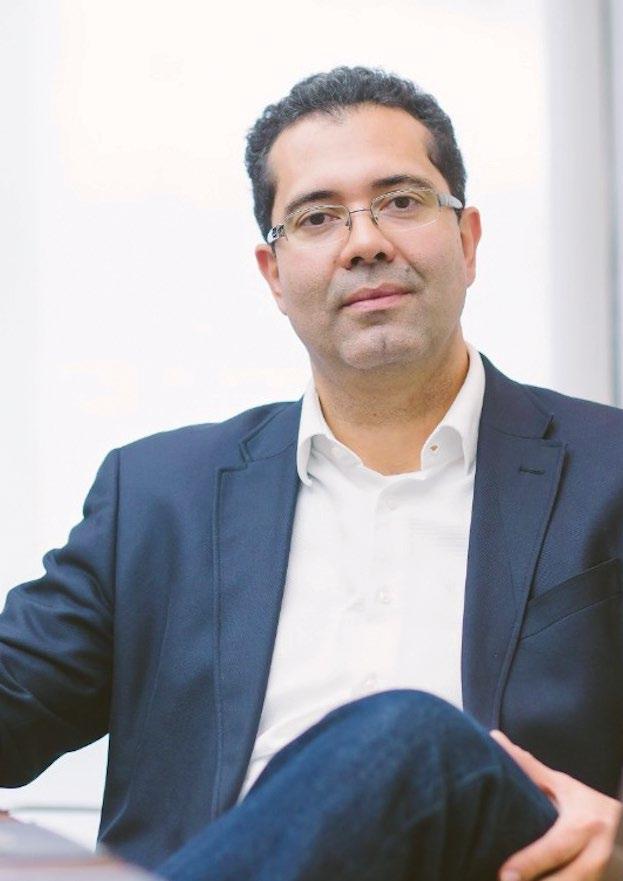
DIVERSIFYING THE FINTECH: PAVING THE WAY TO SUCCESS
Once a magnet for venture capital, the fintech sector saw investments drop across the UK for the first time in 2023. With eight years of running a BNPL provider, Samantha Fogerty, COO of Payl8r, discusses how a diverse workforce could help protect the growth of the sector.
Fintech has famously lagged behind other sectors when it comes to diversity. According to Deloitte, less than 30% of the fintech workforce is female, reducing to just 17% in leadership positions. And with the sector’s gender pay gap currently estimated at 22%, we risk disincentivising more women to join. Fintech isn’t just behind when it comes to gender either, a 2022 report found that just 38% of fintech workers felt their organisations employ ‘underrepresented ethnicities’. It’s clear that there is a disconnect between diversity and fintech but could this be stunting innovation?
Despite the dip in investment last year, we are still a growing industry that sees new start-ups enter each day, meaning innovation is crucial to success. Diversity could play a pivotal role in helping businesses drive innovation and unlock their competitive edge.
An untapped talent pool
The truth is that without diversifying our workforce, we are missing out on an untapped talent pool that has the potential to breed major innovation through new perspectives. Our industry is centred around problemsolving for the general population which is split fairly evenly between males and females. So achieving equal input from both men and women across the board is paramount to ensuring our products resonate with this range of end-users. Research shows that businesses with higher diversity in their workforce are 70% more likely to capture new markets. Without a commitment to diversifying our sector, we are disadvantaging ourselves and our market.
Finding power in the unconventional
I’ve never classed myself as a feminist. But I do believe in finding value in the
diversity of life experiences. My entry into the industry wasn’t conventional, coming from a sales background I was always more people-focused, and I never saw myself as analytical. However, my life experience as a young person taking control of my finances helped me to understand that millennials represented a whole generation who didn’t have access to lending. This ended up forming the USP for our start-up. Just imagine the other problems out there, waiting for the right minds in our industry to help fix them.
Using empathy to enhance creativity
It's not all about idea generation either, we should be embracing a diverse approach to people management as well. As someone with a traditionally female management style, leading with empathy and emotion, I find it easy to understand and relate to my team. This inherent ability to see my team as people before employees has allowed me to achieve high staff retention rates over the years. This is a clear business case for celebrating traditionally female traits in senior leadership.
Empathy might be more crucial for our sector than we realise. A study has found that people who work in technology are five times more likely to be depressed than the general UK population. This raises questions about the implications of having a disproportionate balance of male-tofemale leaders. We should be asking if this could be reduced by bringing in more ‘female forward’ skills to the sector. After all, it’s widely understood that depression stunts productivity, meaning it makes good business sense to protect the well-being of our workforce.
Stepping into diversity
How do we begin to implement progression in this area? And who should take responsibility? There are steps the industry can take to incentivise a diverse workforce, starting by addressing the disparity of the current pay gap. Pay
shouldn’t be based on gender, ethnicity or any form of personal identity. But rather the skills of the individual and the value they add to their role.
There are steps that the current workforce can take as well. I would encourage male workers to ensure they’re listening to, and valuing, ideas from people who don’t look and sound like them. I have experienced my views being dismissed by people who possibly couldn’t see past my age and gender. This way of thinking is outdated and limits potential, having an open mind helps to spark innovation and therefore fosters leadership.
Ultimately, the main power lies with the individual. Taking risks and believing in ourselves is crucial to success in fintech and any other industry. I have never been one to indulge in victimising myself, instead I fight back with determination. There are situations for anyone that can carry an element of imposter syndrome and a fear of the unknown, but these are what push us outside of our comfort zone. The opportunities to use your individuality are when your power grows and your distinct voice becomes louder.
Looking to the future
Success should never be by personal identity, it should be about the unique skillset that’s brought to the table. Our personal experiences and perspectives of the world cultivate a greater understanding of the markets we’re tapping into, and ultimately allow us to create innovations that enrich our societies. Our industry can do more to diversify, but as individuals, we need to take the reins to define our own narrative. The industry will only see diversification if each of us can develop a strong sense of self-belief to take that leap of faith into the unknown.

Featured Story 32 Back to the Table of Contents
Samantha Fogerty, COO, Payl8r

Payl8r, a pioneering force in the 'buy now, pay later' market, proudly presents its dynamic chief operating officer, Samantha Fogerty, 35, whose visionary leadership has catalysed the company's rapid ascent in the UK’s competitive fintech sector. Since Samantha Fogerty took the reins in 2016, Payl8r has experienced exponential growth with a 334% increase in lending volume, while doubling its workforce each year.
 Sarah Whipp, CMO, Spendesk
Sarah Whipp, CMO, Spendesk
Fintech continues to be a true hotspot of pioneers – revolutionising transactions, improving cost-effectiveness, and streamlining customer experience. The sector has strived to be one of the more progressive tech fields in terms of diversity but, while we should celebrate this intent, we shouldn’t stop talking about female equality in fintech until the issue is outdated, like talking about the problems with 2G.
It is great that we measure global data for the fintech sector, with women in around 11% of board seats and 6% of CEO roles, but beyond the need to improve those topline numbers, female fintech leaders in the UK specifically cite low recognition for their contribution (27%) and opaque promotion processes (25%) as challenges to career progression. This indicates that to truly tackle the debate we have to go deeper than topline figures, which can often mask reality for the majority of women.
So how can the industry address this challenge, and why is it important?
More than a ‘numbers game’
Senior gender equality isn’t just important for meeting representation quotas; it’s also vital for business health. Globally, companies who prioritise executive-level gender diversity have a 21% likelihood of outperforming industry peers with lower diversity rates, and are 27% more likely
HELPING WOMEN THRIVE IN FINTECH
to perform better on longer-term value creation.
More than this, failing to provide an adequate gender balance at senior level denies the fintech industry fair representation and tangible female role models. It also leaves organisations less capable of addressing a diverse global customer base and working towards financial inclusion. A recent study supports this, revealing a gender disparity in the fintech user base with 29% of men using products, compared to 21% of women.
Not just trailblazers
Resolving these challenges requires careful consideration of not just how to achieve balance, but also what the right balance is. Senior trailblazing roles are not for every woman, or indeed every man, and equality needs to be felt daily, by all, in truly inclusive environments. We need to raise the bar for everybody, rather than having a few outstanding companies.
The best approach is diverse hiring at every level; ensuring the presence of more women across the organisation and a broad cross-functional representation will widen the pool of experienced female talent ready to both climb the ranks and normalise equality for the next cohort .
Alongside this, companies should review their policies to secure fair opportunities for all, and commit to consistent salary bands to ensure parity.
Winning women to fintech
In addition to equal gender opportunities, there are other key factors that make a career in fintech more attractive to women. For instance, employees who are parents – both men and women – need support in this dual role. But it is women who usually suffer as a result of a lack of childcare support, with one in five in the EU prevented from working more hours, despite wanting to, because of childcare challenges.
To this end, fintech companies can make it easier for women by embedding flexibility into their culture and focusing on individuality and output, rather than on location and set working times. This flexibility must also take into account the changing needs of women throughout their lives – with clear policies in place around pregnancy, childcare, and menopause, for example.
So, finally, what can women starting out in fintech do to improve their own prospects? I would suggest finding a sponsor or mentor; someone to be a pathfinder who can share past experiences with them, and talk about them positively when they’re not in the room. Women often feel they have to go it alone, but they don’t.

Featured Story 34 Back to the Table of Contents

EMPOWERING WOMEN IN FINTECH: ANASTASIIA BRENER'S TRAILBLAZING JOURNEY
In the world of fintech, where innovation knows no bounds, Anastasiia Brener stands as a testament to the limitless possibilities of dedication and expertise. Anastasiia's journey to the pinnacle of fintech leadership has been nothing short of extraordinary. With nearly a decade of experience spanning Fintech, payments, payment processing, and Software as a Service (SaaS), she brings a wealth of knowledge to her role.
In an exclusive interview, Anastasiia shares her insights into the fintech industry, her experiences, and the challenges she's overcome as a woman in this dynamic sector. From breaking barriers to fostering inclusivity, she sheds light on her remarkable journey. Join us in this captivating interview as we gain deeper insights into Anastasiia Brener's inspiring career, her views on the fintech landscape, and her vision for the future of the industry.
Financial IT: Can you tell us about your journey to becoming the Chief Commercial Officer at Akurateco?
Anastasiia Brener: My journey to becoming the Chief Commercial Officer at Akurateco has been quite a ride in the fintech world. I've spent nearly a decade in this industry, gaining experience in Fintech, payments, payment processing, and Software as a Service (SaaS). Before stepping into the role of CCO, I had a significant role in Sales and Business Development, where I fine-tuned my skills in client acquisition and built strong industry relationships. Over time, I've become adept at structuring sales processes, nurturing partnerships, and aligning sales with marketing strategies.
My tenure before Akurateco was a valuable learning experience that prepared me for this role, where I now use my knowledge to drive innovation and sustainable growth within the company. The experiences I gained in my previous roles not only improved my technical skills but also helped me develop a strategic mindset, which is crucial in my current role as CCO. This background has been instrumental in shaping the comprehensive commercial strategies at Akurateco, where I'm focused on leveraging this
wealth of knowledge to drive innovation and ensure the company's growth.
Financial IT: Fintech is often perceived as a male-dominated sector. Can you discuss any challenges you’ve faced as a woman in this industry and how you overcame them?
Anastasiia Brener: Absolutely, navigating the male-dominated fintech sector has been a journey filled with unique challenges that I've had the privilege to overcome. One of the keys to breaking these barriers and promoting inclusivity has been my relentless focus on showcasing my expertise and leadership skills. I've found that surrounding myself with highly motivated, smart, and talented women has been incredibly empowering, and together, we've built a robust support network both within and outside our organisation.
Mentorship has played a pivotal role in my professional growth. I actively seek guidance from seasoned professionals in the fintech industry while also offering my own knowledge to others. This exchange of insights has provided me with invaluable perspectives for navigating the ever-evolving dynamics of the industry and refining my leadership strategies.
It's heartening to witness the progress made in the fintech sector regarding gender diversity over the last 5-10 years. Each passing year brings a gradual improvement in the representation of women, signalling positive shifts in the industry's landscape. While the journey towards achieving greater gender equality is ongoing, it's truly encouraging to see these significant strides being made.
This changing landscape isn't just confined to fintech; it's part of a broader trend where having intelligent and capable women in high-ranking positions is no longer just a necessity—it's becoming a defining trend that's reshaping industries for the better.
Financial IT: How has your role evolved from Head of Sales to Chief Commercial Officer at Akurateco? What are the key differences and new responsibilities you’ve embraced?
Featured Story 36 Back to the Table of Contents

Anastasiia Brener: My transition from Head of Sales to Chief Commercial Officer at Akurateco marked a significant evolution in my role. While Head of Sales focused on driving revenue through client acquisition, as CCO, I've assumed broader responsibilities. Beyond sales, my purview now includes business development, sales, and strategic planning.
The shift entails a comprehensive understanding of the business landscape, aligning sales activities with overarching commercial strategies, and steering the company's overall growth. Embracing these multifaceted responsibilities, I play an important role in shaping and executing the comprehensive commercial strategy at Akurateco.
Financial IT: From your perspective, how is the representation of women in fintech changing, and what more can be done to encourage female participation and leadership in this sector?
Anastasiia Brener: The representation of women in fintech is gradually improving, but there's room for growth. Encouraging female participation necessitates proactive efforts, such as mentorship programs, networking opportunities, and initiatives to highlight successful women in the industry. Importantly, there are already conferences promoting special tickets for women, as well as specialised women-oriented fintech conferences, forums, and other events happening globally. Fostering inclusive cultures within companies is also pivotal.
Financial IT: Having attended numerous fintech conferences, what unique perspectives do you believe women bring to these industry gatherings?
Anastasiia Brener: Women in fintech offer diverse and valuable perspectives at conferences. We bring a holistic understanding that considers both the technological and societal impacts of innovations. Our backgrounds promote collaboration, bridging gaps between different areas of expertise. We prioritise user
Anastasiia Brener, Chief Commercial Officer, Akurateco Payments Orchestration Company
Anastasiia is the Chief Commercial Officer at Akurateco Payments Orchestration Company, founded in 2019. With over 8 years of experience in the field, Anastasia directs the expansion of Akurateco’s clientele and partnerships worldwide. Since 2021 she has been managing the commercial team that handles the sales and project management operations of Akurateco, which delivers easily customizable PCI DSS-certified white-label payment software to payment service providers and international merchants.
experience and ensure that fintech advancements are accessible to a wide range of people. As leaders, our presence inspires the next generation and promotes inclusivity. Our strategic vision anticipates future trends, guiding the industry toward sustainable growth.
In essence, women bring a rich spectrum of unique perspectives, from ethical considerations to user-centric design and forwardthinking strategies.
Financial IT: How important has mentorship been in your career, and do you currently mentor other women in fintech?
Anastasiia Brener: Mentorship has been a cornerstone of my decadelong journey in fintech, providing invaluable guidance and shaping my trajectory. Having navigated challenges and breakthroughs, I understand the impact of mentorship on personal and professional growth. Recognizing its significance, I'm committed to paying it forward by actively mentoring other women in fintech. It's not just about career advice; mentorship fosters a culture of diversity, inclusion, and collaboration, essential for industry progress.
When I initially entered the industry, I was quite unfamiliar with it. A university degree doesn't truly prepare you for the practical aspects of payment processing and fintech in general. However, I quickly adapted, never ceasing to explore. Honestly, this advice is something I frequently share – to maintain your curiosity and never stop learning. When I impart my knowledge, I feel truly inspired, and my eyes light up.
Financial IT: How do you balance the demands of being a high-level executive with personal development and growth?
Anastasiia Brener: Balancing these demands requires intentional choices. In my decade in fintech, I prioritise by allocating specific time blocks for professional development. Effective delegation empowers my team, fostering collaboration and mutual growth. Maintaining a work-life balance is crucial for sustained
Spring Issue • 2024 Featured Story 37 Back to the Table of Contents
performance, achieved by setting clear boundaries and prioritising self-care. Networking is a catalyst for growth; engaging in industry events and forums keeps me connected and inspired.
I have a rule: during breakfast, lunch, or dinner with my family, phones are off, and our focus is solely on each other. This intentional quality time enhances both my personal life and professional well-being. Adaptability is key in the dynamic fintech landscape, allowing me to adjust personal growth strategies based on evolving priorities. It's a holistic approach that harmonises professional responsibilities with personal development, ensuring lasting success and fulfilment in both realms.
Financial IT: What are your predictions for the future of the fintech industry, particularly regarding the inclusion and impact of women?
Anastasiia Brener: I'm quite optimistic about the future of the fintech industry, especially when it comes to the inclusion and impact of women. We're on the cusp of a transformative shift where women will play even more significant roles. Gender stereotypes are gradually fading away, and women are being recognized for their diverse capabilities and contributions.
As women, we're not just participants in this industry; we're catalysts for progress and innovation. We bring unique perspectives and ideas to the table, which will continue to shape a more inclusive and innovative future for fintech. I believe that our presence and influence will be pivotal in driving the industry's growth and development. So, the future looks bright, and I'm excited to see the positive changes that women will bring to the fintech landscape.
Financial IT: What advice would you give to young women aspiring to carve out a career in fintech?
Anastasiia Brener: Embrace curiosity and continuous learning. The fintech landscape is dynamic, and staying informed about emerging technologies and industry trends is key. Don't be afraid to take risks; it's through challenges that we grow. Build a strong network, seek mentors, and actively participate in industry events. Your unique perspective as a woman is an asset – leverage it to contribute to innovation. Lastly, believe in yourself and your abilities; confidence is a powerful driver of success in the everevolving world of fintech
Financial IT: How does Akurateco support diversity and inclusion, particularly for women in tech and leadership roles?
Anastasiia Brener: My company is dedicated to promoting diversity and inclusion, with a special focus on supporting women in tech and leadership roles. Our efforts include actively seeking diverse talent through inclusive hiring practices and offering mentorship
programs and leadership training specifically tailored for women. We believe in open and transparent discussions about diversity within our workplace and have implemented policies that support a healthy work-life balance for all our employees. Our goal is to create an environment at Akurateco where everyone, regardless of their background, can thrive and contribute to our success.
Financial IT: In your view, how are emerging technology trends shaping the future of payment solutions and what role do women play in this evolution?
Anastasiia Brener: Emerging technology trends are reshaping payment solutions. Women contribute diverse perspectives and innovative ideas, enhancing creativity and ensuring that technologies meet diverse user needs. As contributors, leaders, and decision-makers, women drive progress and inclusivity, making payment solutions not just technologically advanced but also userfocused.
Financial IT: Can you share your strategies for maintaining a work-life balance and how Akurateco supports this balance for its employees?
Anastasiia Brener: At Akurateco, we prioritise the well-being of our employees. Personally, I adhere to a structured schedule, setting clear boundaries for work and personal time. Akurateco supports work-life balance through flexible schedules, and fully remote work, enabling employees to manage their time effectively. The company values open communication, allowing for transparent discussions about workload and expectations. Additionally, we promote a culture that respects downtime and encourages employees to recharge. These strategies collectively contribute to a healthy work-life balance, fostering a positive and sustainable work environment at Akurateco.
Anastasiia Brener's story is a beacon of inspiration for women in fintech. Her relentless pursuit of excellence, her dedication to mentorship, and her vision for a more inclusive industry pave the way for a future where women continue to shape the fintech landscape.
Join us in celebrating Anastasiia's achievements and in looking forward to a future where more women, like her, will rise to prominence in the ever-evolving world of fintech.

Featured Story 38 Back to the Table of Contents
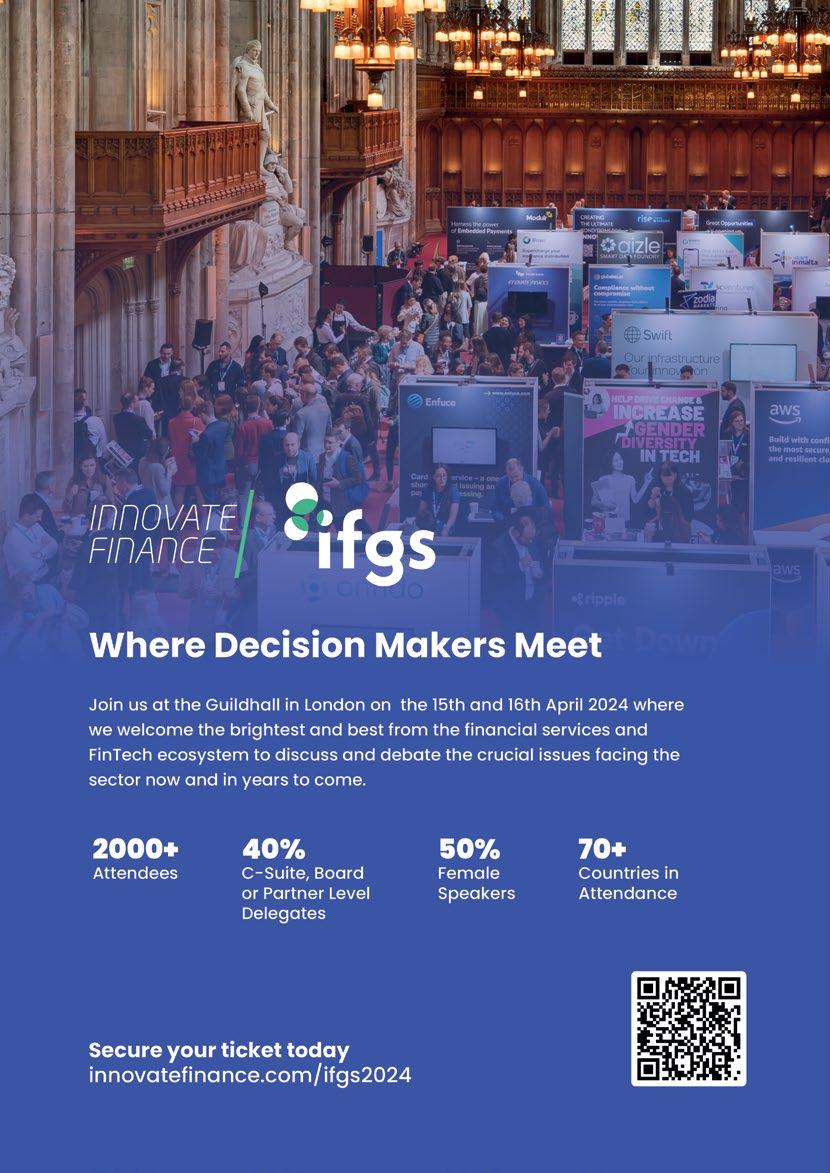
CYBERSECURITY: THE HUMAN FACTOR
Discussion between Anthony Weeks and Dr. John Wensveen

Anthony Weeks, Chairman and Managing Director of the SEDI-CASE: ARCIPELO-TECH/BrVo Cybersecurity Initiative, in partnership with US HART and RX5 Cybersecurity Strategic Alliance. He is also De Facto Ambassador and Special Economic Envoy to Taiwan and the Asia-Pacific Region.
No-one disputes that cybersecurity is vital. Governments, countries and other organizations need to consider the likelihood of cyberattacks by bad actors and the potential costs of such cyberattacks.
Cybersecurity requires skilled people – and that is the challenge. Research consultancy CyberSeek reports that there are approximately 1.1 million people employed in cybersecurity in the United States with almost 600,000 currently unfilled positions. Worldwide, the cyber workforce shortfall will likely be 3.5 million people by 2025, according to Cybersecurity Ventures, another research organization. Another survey found that 90% of cybersecurity professionals interviewed globally considered that their teams lack the skills that are needed to fully protect their organizations against cyberattacks.
An additional issue is that the pool of cybersecurity talent lacks diversity. According to a recent workforce study from ISC2, only about 25% of the cybersecurity workforce around the world is female. Another ISC2 study indicated that, although cybersecurity teams are becoming diverse, this is happening slowly. Its research shows that 70% of cybersecurity workers 60 and older are white men, 13% are white
women,15% are non-white men and 2% are non-white women.
With this worrying background,
Financial IT hosted a discussion between Anthony Weeks, Technology Market Expert and internationally recognized cybersecurity expert Dr. John G. Wensveen –whose biographies are shown below.
Anthony Weeks: Who is responsible for cybersecurity in the workplace?
Dr. John G. Wensveen: Cybersecurity is everyone’s responsibility because one mistake could cause significant damage to an organization. It involves many stakeholders at different levels.
The primary responsibility falls to the leadership team in the C-Suite, who are tasked to set the overall cybersecurity strategy, policies, and budgets for the organization.
Additionally, the Information Technology department plays a crucial role implementing and managing cybersecurity measures including securing networks, systems, and applications.
Employees are responsible for adhering to security policies, being vigilant against attacks like phishing, by using strong passwords, and following best practices for data protection.
Featured Story 40 Back to the Table of Contents
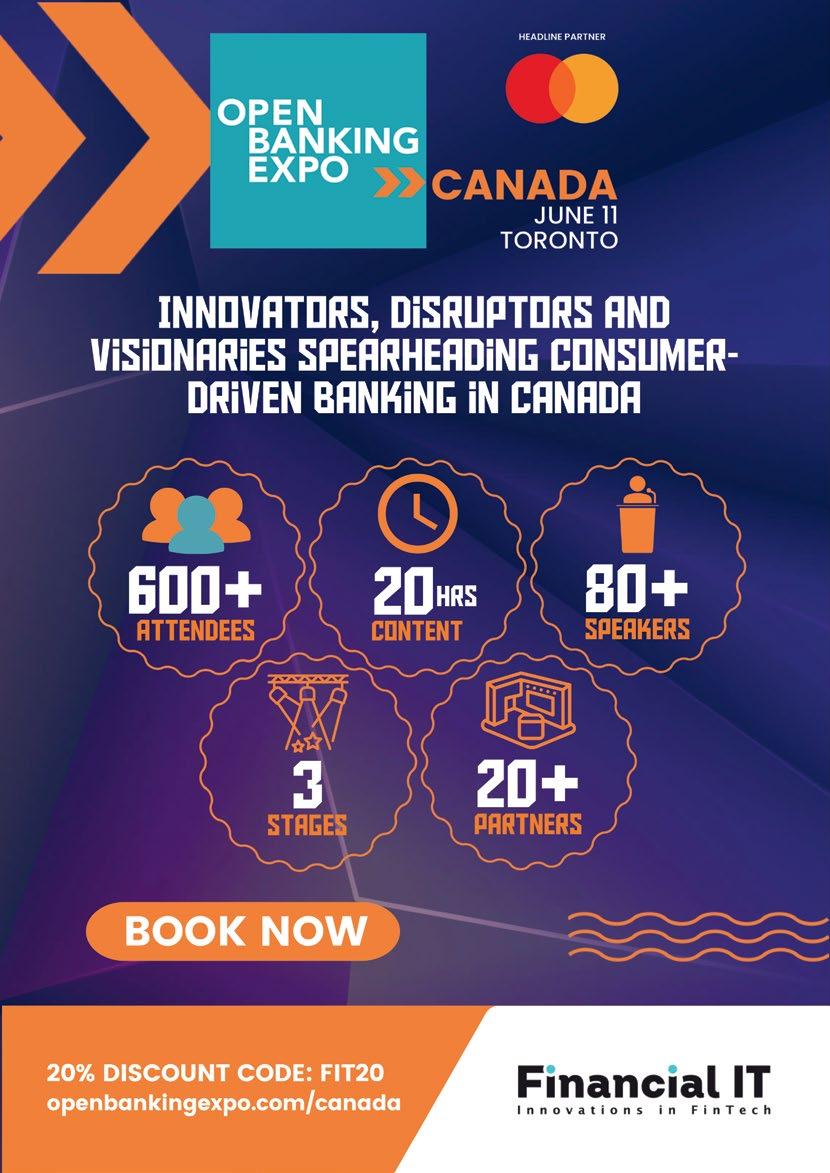
 John G. Wensveen, Ph.D., Chief Innovation Officer, Nova Southeastern University, Executive Director for the Alan B. Levan NSU Broward Center of Innovation, Official Advisor on Innovation, Technology and Entrepreneurship to the Broward County Mayor, Official Member of the Forbes Technology Council.
John G. Wensveen, Ph.D., Chief Innovation Officer, Nova Southeastern University, Executive Director for the Alan B. Levan NSU Broward Center of Innovation, Official Advisor on Innovation, Technology and Entrepreneurship to the Broward County Mayor, Official Member of the Forbes Technology Council.
In select cases, organizations engage external cybe rsecurity experts or employ third-party services to conduct assessments, penetration testing, and provide additional layers of security.
One of the greatest c hallenges related to cybersecurity, particularly within larger organizations, is the potential for disconnects between C-Suite, the Board of Directors, and other levels within the organization.
The Alan B. Levan | NSU Broward Center of Innovation recognizes the challenges to this combined group. One of the strengths of the NSU Cyber Range is a program that “links” the C-Suite, and the Board of Directors together to keep them updated on the trends, challenges, opportunities, and strategies leading to enhanced security measures. We believe that our Cyber Range is unique in the global marketplace.
Anthony Weeks: Let’s talk specifics. What does the Cyber Range seek to do?
Dr. John G. Wensveen: The overall aim is to protect the information infrastructure of the United States.
NSU is a part of the Nati onal Center of Academic Excellence in Cybersecurity (NCAE-C) – Cyber Defense (CD) program: this seeks to increase the number of well trained and skilled professionals with a higher education in the field of cybersecurity.
The Alan B. Levan | NSU Broward Center of Innovation’s Cybersecurity Range supports NSU’s academic cybersecurity programs as well as industry and government clients.
The Levan Center of Innovation is housed within a 54,000 sq. ft. purposebuilt facility which includes a militarygrade Cyber Range.
In short, the NSU mission is to equip organizations with the knowledge and skills needed to proacti vely tackle cyber threats.
Anthony Weeks: Great. What recent developments would you highlight?
Dr. John G. Wensveen: Visible progress is made in advancing cybersecurity as a profession. The National Science Foundation announced $24 million in grants for cyber education at universities. The U.S. Department of Labor announced $65 million in grants for the development of cybersecurity apprenticeship programs.
The National Institute of Standards and Technology has spent $3.6 million to fund cybersecurity workforce and education projects.
Anthony Weeks: So, this is basically being led by the public sector?
Dr. John G. Wensveen: The private and non-government sectors are also playing valuable roles. The advocacy group Black Tech Street recently announced a collaboration with Microsoft aimed at creating more than 1,000 jobs for Black cyber professionals. The Center for Cyber Technology Innovation will provide 200 utilities with cybersecurity training. The philanthropist Craig Newmark announced cybersecurity-focused grants of $100 million. Google is providing $20 million to fund cybersecurity education.
These are just a few cybersecurity funding initiatives that are being taken around the globe.
Anthony Weeks: How would you sum up all this in a few words?
Dr. John G. Wensveen: Advanced technology and innovation are transforming people’s lives, infrastructure, and societies across the globe – and at warp speed.
There are incredible b enefits derived from the use of technology to enhance how we choose to live our lives today.
The flip side is that, in the wrong hands, technology can reap havoc as a disruptive and destructive force!
We must plan and prepare for the inevitable security threats to these machines, devices, and systems as we become dependent upon them.
Technology advancements in the short term typically outpace the workforce needed to supply protections to the marketplace.
It is necessary to invest in cybersecurity education, training, and skill development. This will ensure the ability to counter and mitigate technical glitches, disruptions, and attacks from bad actors.
Organizations must act now and invest in cybersecurity skills that will provide that much needed peace of mind.
The importance of the human factor cannot be overstated!
Anthony Weeks: Thank you.
Featured Story 42 Back to the Table of Contents








 Andrew Hutchings, Editor-In-Chief, Financial IT
Andrew Hutchings, Editor-In-Chief, Financial IT


 by Chris Principe, Publisher, Financial IT
by Chris Principe, Publisher, Financial IT





 Siamac Rezaiezadeh, VP of Product Marketing and Insights, GoCardless
Siamac Rezaiezadeh, VP of Product Marketing and Insights, GoCardless



 Adam Vissing, VP Sales & Business Development, IXOPAY
Adam Vissing, VP Sales & Business Development, IXOPAY






 SVP,
SVP,












 Sarah Whipp, CMO, Spendesk
Sarah Whipp, CMO, Spendesk






 John G. Wensveen, Ph.D., Chief Innovation Officer, Nova Southeastern University, Executive Director for the Alan B. Levan NSU Broward Center of Innovation, Official Advisor on Innovation, Technology and Entrepreneurship to the Broward County Mayor, Official Member of the Forbes Technology Council.
John G. Wensveen, Ph.D., Chief Innovation Officer, Nova Southeastern University, Executive Director for the Alan B. Levan NSU Broward Center of Innovation, Official Advisor on Innovation, Technology and Entrepreneurship to the Broward County Mayor, Official Member of the Forbes Technology Council.



